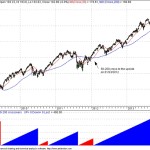How To Trade the Stock Market in 2014 | Price Action Lab Blog

Here is my list of principles for trading the stock market in 2014.
The stock market delivered substantial gains to patient traders in 2013 and especially to those who ignored pundits and managed their risk properly. Although the total return of SPY was 29.85%, anyone who made more than 19% can claim significant performance. It is not reasonable to expect anyone, even the best of the best, to match buy and hold total returns of a bull market while actively managing risk. Sometimes the market rewards those who blindly follow it with naive indicators, like for example a 50-200 moving average crossover that during 2013 never crossed to the downside and thus it matched the buy and hold return. However, do not expect blind trend-following with no intelligence to continue being profitable for long. All parties have an end, often abrupt.
Principles
Principle 1: Do not try to predict the future
Unless one is a certified clairvoyant and has passed the tests must not try to predict. The future is simply unknown. There are many factors, known and unknown, that can move the market in any direction and the chances of a correct prediction are even. It is like tossing a coin. Does anyone want to bet all of her investment money on the next outcome of a coin toss?
Principle 2: Avoid techniques used by uninformed noise traders
Chart patterns, visual technical analysis and naive indicators are tools for training confirmation bias. Some very experienced traders use these methods for risk management but for their main decisions mainly depend on tape reading. It is better to use a simple moving average crossover, like the 50-200 cross, that has been on a long SPY trade since 01/23/2012, almost two years now, and has done an excellent job of following the market for the past 490 trading days, as shown on the chart below:
The 490-day party shown above will end at some point but unless someone is sophisticated enough to emulate trend-following gains via lower risk short-term trades then for most purposes the above system suffices to follow the market although it has no adaptation intelligence. The downside is that this system performs exceptionally bad when the market becomes choppy. Everyone should understand the pros and cons of blind trend-following.
Principle 3: Do not listen to pundits and do not try to pick stocks unless you are an expert financial analyst
Most pundits are naive speculators and some of them serve their own purposes. Their recommendations average to noise and rarely provide any edge because of information efficiency.
Unless one is an expert in analyzing companies then stock picking is no different than a monkey throwing darts on newspaper quotes. ETFs are better vehicles for retail traders because via a small management fee they capture alpha when it is there. Stock picking is the job of expert financial analysts.
Stock scanning with naive technical criteria for picking stocks is what characterizes naive quants. The blogosphere and social networks are full of those. The major issue they ignore is that one cannot assume that a filter for scanning is a profitable method and even if that is true, a step they often omit, quite often the trade samples are very small for significance. Stock scanning when done properly is a very involved methodology that requires very careful analysis.
Summary
It is pointless trying to predict the future, listening to pundits, picking stocks when lacking the expertise and using naive quant analysis. It may be much better to use simple trend-following methods when sophisticated analysis capability is not present. The market had a good run in 2013 and there are more good signs than bad for 2014. However, some of the bad signs, like for example the Hurst exponent, point to a substantial correction in 2014, which is not necessary to occur but the risks is there.
Disclosure: no relevant positions.
Charting program: Amibroker
Disclaimer
Visit site –
How To Trade the Stock Market in 2014 | Price Action Lab Blog
See which stocks are being affected by Social Media

